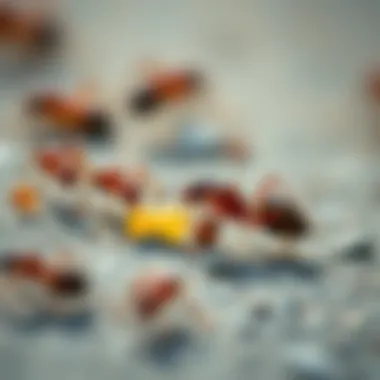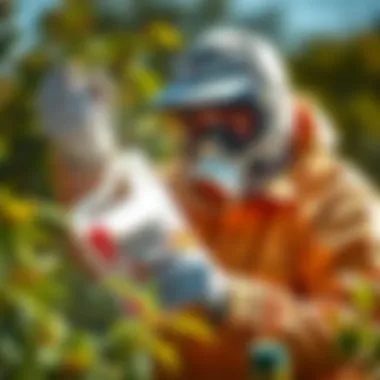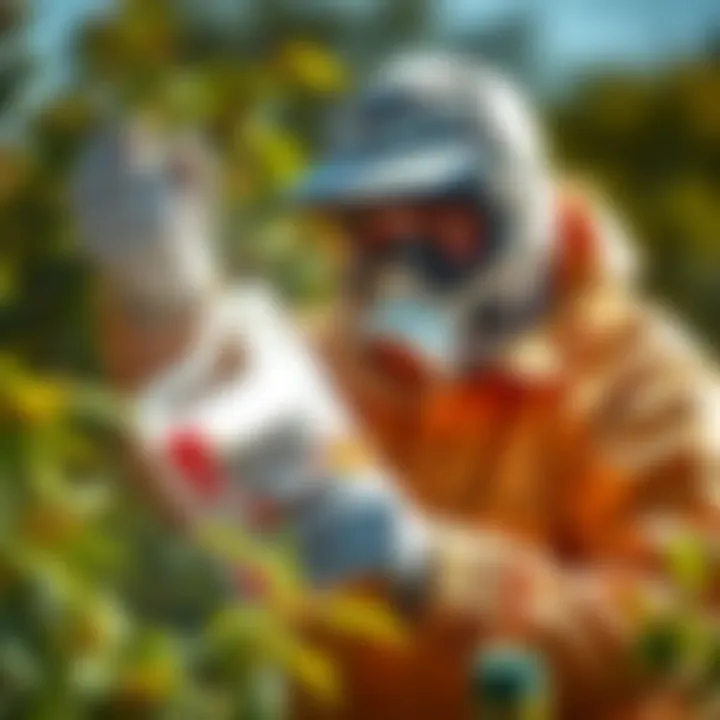Effective Ant Control Using Boric Acid Techniques


Intro
Ants can be more than just a nuisance; they can invade our homes, contaminate our food, and disrupt our peace of mind. Homeowners often seek effective methods to deal with these tiny intruders, and one option that’s garnering attention is boric acid. This naturally occurring compound offers both efficacy and safety in combating ant populations without resorting to harsh chemicals. Understanding the nature of ants, their life cycle, and effective methods of control can significantly simplify the pest management process.
In this article, we will explore how boric acid works, its benefits, possible drawbacks, and safety considerations, in the context of controlling ants. We aim to provide a comprehensive understanding of this compound, alongside practical advice to help housewives and homeowners manage their ant problems effectively.
Understanding the Pest
When tackling an ant problem, the first step is understanding the pest itself. Different species of ants have various behaviors and habits which can influence the choice of control method.
Identification
Identifying the species of ant invading your home is crucial. Common types include:
- Carpenter Ants: Large, black or bicolored ants that can damage wooden structures.
- Odorous House Ants: Small and dark, they emit a smell akin to rotten coconut when crushed.
- Ants with Wings: These could be reproductive females or male ants looking to mate.
Life Cycle
Understanding the life cycle of ants can provide insights into when and where to apply control methods. The ant life cycle consists of four stages:
- Eggs: Laid by the queen, these tiny white or cream-colored eggs can be difficult to spot.
- ** larvae:** After hatching, the larvae appear similar to tiny worms. They are fed by worker ants.
- Pupae: In this stage, larvae transform into adult ants. This part of the life cycle may resemble an adult ant but is often in a cocoon-like state.
- Adults: Fully matured ants emerge as worker ants, males, or queens, ready to start the cycle anew.
Pest Prevention Strategies
Preventing ants from becoming an issue in the first place is often more effective than trying to eradicate them once they're present.
Environment Modification
Making your home less inviting to ants can deter them from coming inside. Some strategies include:
- Sealing Cracks: Fill in gaps around windows, doors, and foundations where ants might enter.
- Cleaning Up: Keep food in sealed containers, immediately clean spills, and dispose of trash promptly to remove food sources.
- Yard Maintenance: Trim back trees and shrubs that touch your home, as they can act as highways for ants.
Physical Barriers
Implement physical barriers to keep ants at bay. You can use:
- Ant Traps: Placing traps that use bait can help in identifying ant trails.
- Peppermint Oil: This natural deterrent can be used to create a barrier that ants tend to avoid.
Control Methods
When prevention proves insufficient, effective control methods become necessary.
Chemical Control
Boric acid stands out as a widely used chemical control method for ants. It works by disrupting an ant's digestive system when ingested, leading to slow death. To apply it:
- Create a Bait: Mix boric acid with sugar and water to attract the ants.
- Placement: Put the bait in areas where you've seen ant activity, ensuring it’s out of reach of pets and children.
Biological Control
In addition to chemical options, biological methods may complement your efforts. Introducing natural predators or using beneficial organisms can help keep ant populations under control. For instance, certain nematodes can target ant eggs or larvae, providing a natural solution.
"Often, ants are just searching for food and shelter—by managing our environments, we can make our homes less appealing to them."
For further reading on pest management, you can visit National Pesticide Information Retrieval System or explore resources on Pest Management University of Florida
Foreword to Boric Acid
Boric acid, often dubbed the unsung hero of pest control, plays a significant role in managing ant populations effectively. Understanding its properties and historical significance is crucial for homeowners who seek a practical, eco-friendly solution to pesky ant invasions. This section introduces boric acid, highlighting not just its definition but also its enduring reliance as a pest management tool.
Definition and Composition


Boric acid is a white powder, chemically known as hydrogen borate, with the formula H₃BO₃. It’s naturally occurring and forms from the weathering of boron-containing minerals. The compound itself is comprised of boron, oxygen, and hydrogen. While at first glance its components might appear harmless, boric acid's impressive insecticidal properties stem from its unique structure. It disrupts the digestive systems of ants upon ingestion, leading to their demise.
In essence, boric acid serves as a slow-acting poison. When ants consume it, they unknowingly carry it back to their colonies, ultimately sharing it with other members. This means it doesn’t just target the individual forager but packs a punch to the entire colony – a vital feature that homeowners should appreciate. Thus, boric acid's natural composition makes it a favored choice among many who look for alternatives to traditional chemical pesticides.
Historical Use in Pest Control
Historically, boric acid has been utilized in various cultures for its insecticidal properties, dating back to the late 19th century when it became a staple in the fight against insects in households and agriculture. Its efficacy was quickly recognized, with pest control experts appreciating how it could tackle stubborn infestations without the hazardous effects exhibited by many synthetic chemicals.
In the early 1900s, pest management strategies began to evolve with the introduction of boric acid as a common solution. It offered an edge in dealing with ants and other crawling insects like cockroaches, especially in urban environments. Many homeowners embraced its application due to its low toxicity to humans and pets, marking it as a safer option compared to harsher agents.
Boric acid's reputation has stood the test of time, remaining prevalent in modern pest control protocols. As the world grows increasingly conscious of environmental impacts, its historical use now aligns seamlessly with contemporary desires for less toxic, more sustainable pest control methods. For those craving efficiency without sacrificing safety, boric acid stands tall as a tried-and-true ally in the ongoing battle against invasive pests.
Understanding Ant Behavior
Understanding the behavior of ants is crucial for implementing effective pest control strategies, especially when employing boric acid as a solution. Ants are not just simple insects; they have complex social structures and behaviors that dictate how they interact with their environment and with each other. By diving into the nuances of their sociology and foraging habits, homeowners can tailor their approaches to enhance the efficacy of boric acid treatments.
Social Structure of Ant Colonies
Ant colonies function like well-oiled machines. Each member plays a specific role, which is crucial for the survival of the group. In a typical colony, you’ll find queens, workers, and drones.
- Queens are the reproductive heart of the colony. They lay all the eggs and can live for years, ensuring the continuity of the colony.
- Workers, the most numerous, take on various tasks, including foraging for food, caring for the young, and maintaining the nest.
- Drones exist solely for mating purposes and usually die shortly after breeding.
Each role is essential, and disrupting any part of this structure can significantly impact the colony’s overall function. When using boric acid, it is especially important to target the workers. Since they are the ones foraging for food, they are most likely to come into contact with baits laced with this compound. This targeted approach allows for a more efficient eradication of the colony, as workers will carry the boric acid back to their nest and share it with the queen and other members.
Ants communicate through pheromones, a vital part of their social structure. These chemical signals guide workers to food sources and alert them to danger. Understanding this behavior helps in placing boric acid baits along their pathways, increasing the chances of consumption by multiple workers.
Foraging Behavior and Food Preferences
Foraging is a fundamental survival activity for ants. They seek out food not only for themselves but also to nourish their entire colony. Typically, the food preferences of ants are quite flexible, but certain types of food tend to attract them more consistently. Common favorites include:
- Sugary substances, such as honeydew produced by aphids.
- Protein sources, like other insects or meat scraps.
- Fats and oils found in various household products.
This understanding of foraging behavior is vital for pest control endeavors. When using boric acid baits, it’s advantageous to craft them to resemble the types of food ants are naturally drawn to. For instance, mixing boric acid with sugar can entice worker ants. They are more likely to consume it and carry it back to the queen, effectively spreading the solution through the colony.
In addition, timing matters. Ants are generally more active during warmer months, which makes it crucial to deploy boric acid treatments at the right time. Observing their activity can lead to more strategic placements of baits. If a homeowner can pinpoint when they see ants regularly foraging, they can set up baits to maximize the chances of worker ants encountering it.
Understanding the nuances of ant behavior is not just a benefit—it's a game changer when applying boric acid in pest control.
How Boric Acid Works Against Ants
Understanding how boric acid operates against ants is crucial for anyone looking to control these often pesky invaders. This section will shed light on the mechanisms at play and provide insights into how this substance affects ant physiology. Recognizing the science behind boric acid can equip homeowners with the necessary knowledge to implement effective pest control measures in their homes.
Mechanism of Action
Boric acid is a slow-acting insecticide, which allows it to be particularly effective against ants. When ants consume it, boric acid disrupts their digestive system and metabolism. Here’s a bit of a breakdown on how it works:
- Ingestion: Ants are attracted to the sweet bait that often contains boric acid. Once they consume it, the compounds get absorbed into their body.
- Metabolic disruption: Boric acid interferes with the ants’ ability to produce energy. This energy depletion essentially leads to their demise.
- Delayed effects: The slow action is intentional. It gives time for affected ants to return to their colony and share the bait with others, thereby spreading the effects throughout the community.
"A little goes a long way; the delayed action can be the key to wiping out entire colonies."
This mechanism not only targets the individual ants but propagates through their social structure, which is crucial as ants rely heavily on each other for survival and cooperation.
Effects on Ant Physiology
The physiological impact of boric acid on ants is both profound and detrimental. Here are the notable effects:
- Desiccation: Boric acid absorbs moisture from the ant's body, leading to dehydration. Without sufficient water, an ant's survival chances plummet. This desiccation process is quiet but lethal.
- Disruption of nerve function: It appears that boric acid may also interfere with certain nerve functions in ants, leading to abnormal behavior before death. They might lose coordination or the ability to communicate.
- Overall health decline: As their systems begin to fail, the overall health of the colony diminishes. Contaminated ants may show signs of weakness, which makes them more vulnerable to predators.
Understanding these physiological effects helps underscore why boric acid is such a potent ally in ant management strategies. Homeowners can use this eco-friendly method effectively, knowing that they are targeting the core of the problem: the ant's internal systems and social interactions.
In summary, recognizing how boric acid works helps make informed choices about its use in alttering ant populations. With proper application, it proves to be a formidable opponent against these tiny yet troublesome pests.
Application Methods for Boric Acid


The use of boric acid for ant control can be highly effective, but the success hinges significantly on how it’s applied. Understanding the various application methods available can empower homeowners and pest control professionals alike to gain control over pesky ant populations. It's crucial to explore these methods not only to maximize the effectiveness of boric acid, but also to ensure the safety of people and pets around the home. Each application type comes with its own set of advantages and considerations, which we will detail below.
Boric Acid Baits
Using boric acid in bait form has become one of the most popular methods for ant control. Bait stations, often designed to attract ants, usually contain a mixture of boric acid and a food source that the ants find enticing. Here is what makes boric acid baits particularly effective:
- Targeted Approach: Ants are drawn to the bait and carry it back to their colony, where it can affect the queen and the rest of the troop.
- Sustained Effectiveness: Since boric acid works slowly, ants have ample time to distribute the bait throughout their habitat before it takes effect. This can lead to a more comprehensive kill compared to other methods that kill on contact.
- Easy to Use: Bait stations can be placed in strategic locations, reducing the likelihood of accidental exposure to pets or children.
However, it is essential to place them carefully, as they should be out of reach of pets while still accessible to ants. Also, patience is key; results may take several days to appear.
Dusting and Spraying Techniques
Dusting and spraying might sound similar, but they actually cater to different situations when dealing with ant infestations. Here's how these methods stack up:
- Dusting: This method involves distributing a fine layer of boric acid dust in crevices and gaps where ants are likely to travel. Ideal spots include:
- Cracks in walls
- Around windows and doors
- Near ant trails
Dusting can prove effective because the ants unknowingly come into contact with the dust and carry it back to their nests.
- Spraying: A boric acid solution can also be mixed with water for a spraying approach, applicable in larger areas. It's particularly effective for surfaces where ants gather, as it creates a barrier. Just ensure not to oversaturate as it may require more drying time.
Both methods have their merits, but knowing when to use one over the other is critical to success. Dusting provides more localized control, while spraying can help cover broader areas, especially where visible nests are found.
Homemade Boric Acid Solutions
For those who prefer a DIY approach, crafting your own boric acid solution is entirely feasible and often quite cost effective. Here’s a basic guideline on how to create an effective boric acid solution:
- Ingredients: Gather boric acid powder, sugar, and water.
- Mixing Ratio: Combine one-part boric acid with three parts sugar to a cup of warm water, allowing the sugar to dissolve completely.
- Application: Soak cotton balls in this solution and place them in small shallow containers near ant trails or suspected nests.
A useful tip: always monitor the area and replace the saturated cotton regularly for continued effectiveness. This method is often favored not just for its cost but also for its simplicity.
To sum up, selecting the right application method for boric acid in ant control can make a world of difference. A well-planned approach coupled with the right techniques can effectively alleviate ant issues in your home while ensuring safety and efficiency.
"Effective pest management begins with understanding the best application methods for your chosen pest control solution."
For further insights, you can explore resources such as Wikipedia, Britannica, and community experiences on platforms like Reddit.
Safety Considerations
When it comes to using boric acid for ant control, safety is paramount. Understanding the implications of applying this compound is crucial not only for effective pest management but also for protecting your household members and pets. As homeowners seek eco-friendly solutions, it’s vital to approach boric acid with knowledge about its toxicity and the necessary precautions during application. By considering these aspects, you can strike a balance between safeguarding your environment and managing ant populations effectively.
Toxicity to Humans and Pets
Boric acid, while regarded as relatively safe for use in many household applications, does come with specific toxicities that must not be overlooked. Ingestion or excessive exposure can lead to adverse health effects. For instance, children might be particularly vulnerable, given their exploratory nature and tendency to put objects in their mouths. Additionally, pets, especially curious ones like dogs and cats, might mistake boric acid products for food if they are improperly stored or left in accessible areas.
The potential symptoms of toxicity include:
- Nausea or vomiting
- Diarrhea
- Skin irritation in some cases
- Respiratory issues if inhaled
It’s also worth noting that boric acid’s safety profile can vary depending on the amount used and the form in which it is applied (e.g., bait, powder, or solution). Therefore, diligence in understanding the dosage and ensuring that products are suited for household environments is essential.
Protective Measures During Application
To mitigate the risks associated with boric acid use, adopting proper protective measures during its application is necessary. Here’s a breakdown of effective practices:
- Read Labels Carefully: Start by always reading the product label. Manufacturers provide important information on usage and safety.
- Wear Protective Gear: When applying boric acid in powder form, wearing gloves and a mask can help reduce skin and respiratory exposure. This measure is particularly important if you have sensitivities or allergies.
- Limit Access: After applying boric acid, keep pets and children away from treated areas until the product has settled. It’s a good practice to block access to these spots, ensuring safety until the application is dry or no longer active.
- Store Properly: Store boric acid in a cool, dry place, out of reach of children and pets. Use original containers with labels intact or clearly labeled secondary containers.
- Clean Up Residue: After applications, especially with powders or baits, clean up any residual product to further minimize exposure risks.
"Simple precautions can make a world of difference when managing pests responsibly. Knowing how to use boric acid enhances both its effectiveness and safety."
In summary, while boric acid serves as a promising solution for ant control, its use must be navigated cautiously. A thorough understanding of its toxicity, alongside proper application practices, lays the foundation for effective pest management that doesn’t compromise safety.
Efficacy of Boric Acid in Ant Control


When it comes to managing ant populations, understanding the efficacy of boric acid is essential for anyone facing an infestation. This substance, often overshadowed by more common chemical solutions, has proven to be an effective, eco-friendly alternative that homeowners and pest control professionals can turn to. In this section, we will dissect the success rates, limitations, and factors that influence the performance of boric acid as a preferred method for ant control.
Success Rates and Limitations
Boric acid's success as a pest control method largely hinges on the way it interacts with ant behavior. Many studies suggest that boric acid can boast success rates upward of 80% when used correctly. But let's take a closer look at what that really means:
- Effectiveness: It works effectively when ants ingest it as part of their food sources, particularly when incorporated into bait. This method capitalizes on their natural foraging behavior and social structure, making it a strategic choice.
- Time Frame: It's important to set realistic expectations. Unlike some synthetic pesticides that showcase immediate results, boric acid's action can take several days to weeks. This delay can seem like a limitation, but it allows time for the substance to spread throughout the colony as worker ants carry it back to their nests.
- Resistance: A limitation worth noting is that some ant species may develop resistance over time. The effectiveness can wane if the same baiting strategy is used repeatedly, urging a need for variation and adaptability in pest control approaches.
Factors Influencing Effectiveness
Not all applications of boric acid yield the same results; several factors dictate its overall effectiveness:
- Ant Species: Different species of ants respond variously to boric acid. While many common household ants are vulnerable to it, some stubborn types, like carpenter ants, may require additional strategies.
- Bait Composition: The mixture in which boric acid is dispersed is critical. Enhancing the bait with sugars or fats can attract ants much more effectively. Formulating a bait that mimics their preferred diet can lead to significantly higher consumption rates.
- Environmental Conditions: Temperature and humidity play a significant role. Extreme heat or dampness can diminish boric acid's potency, so storage and application conditions matter. Keeping the bait dry and providing it in shaded places can help mitigate such environmental factors.
In summary, boric acid provides a viable pathway for ant control when used with an awareness of its limitations and factors that contribute to its efficacy.
In essence, mastering the art of using boric acid in ant control is not just about having the right product on hand, but also about understanding the dynamics of ant behavior, bait composition, and environmental challenges. With thoughtful application, homeowners can tap into the strengths of this remarkable substance.
Alternatives to Boric Acid for Ant Control
Exploring alternatives to boric acid can be a significant part of any ant control strategy. While boric acid has proven effective, understanding other options allows households to choose methods that best suit their specific needs and values. It's important to consider each alternative's effectiveness, safety, cost, and ease of use. This way, homeowners can be fully equipped to tackle their ant problems without relying solely on one solution.
Natural Remedies
Natural remedies offer a multitude of benefits when it comes to ant control. They are generally safer for pets and children, which is a huge plus for families. Here are a few popular alternatives:
- Diatomaceous Earth (DE): This fine powder, made from the fossilized remains of tiny aquatic organisms, is a mechanical insecticide. It damages the exoskeleton of ants, leading to dehydration and death when they come into contact with it. It's safe for humans and is often hailed as a household staple for pest control.
- Vinegar solution: Mixing equal parts vinegar and water can create a strong repellent. Spraying this solution around entry points disrupts ant pheromone trails and can help deter them from returning.
- Essential oils: Scents like peppermint, tea tree, and citrus can repel ants when used as sprays or in diffusers. Simple mixtures of essential oils with water can provide a pleasant aroma while helping control ant populations.
Benefits of Natural Remedies:
- Environmentally friendly: They often contain no harmful chemicals that can harm both the ecosystem and human health.
- Economical: Many natural remedies use ingredients commonly found in households, making them cost-effective choices.
Integrating Boric Acid into Pest Management Plans
Boric acid offers a unique strategy in pest management that, when integrated properly, can yield impressive results in ant control. Understanding its role in a broader pest management plan is essential for homeowners and pest control professionals alike. This section outlines the benefits of diligently incorporating boric acid into ant control strategies and the considerations that should guide its application.
Comprehensive Strategies for Ant Control
To effectively manage ant populations using boric acid, it's vital to adopt a comprehensive strategy that doesn't rely solely on one method. A balanced approach can tackle existing infestations while preventing future ones. Here’s how you might construct such a strategy:
- Assess the Situation: Begin with identifying the type of ants you are dealing with. Different species may respond variably to treatments involving boric acid. Knowledge of their habits can greatly influence your application technique.
- Combine Methods for Impact: Complement boric acid use with other control methods, such as sanitation, exclusion, and monitoring. Keeping your environment clean and sealing entry points aids significantly in reducing ant activity.
- Create Baits: As established, baits using boric acid are effective if configured correctly. Mixing the boric acid with sugar or honey can attract ants, allowing them to ingest the poison and carry it back to their colony.
- Timing of Applications: For maximum altitude, apply boric acid during peak foraging times when ants are active. Pay attention to seasonal variations in ant behavior and adjust your applications accordingly.
Implementing an integrated pest management plan rooted in these strategies can provide not only immediate relief from ant issues but also long-term prevention.
Monitoring and Evaluation
Monitoring is vital in any pest management plan, especially when using boric acid for ant control. After implementing your strategy:
- Observe Activity: Regularly check the effectiveness of your boric acid application by observing ant activity. Look for declines in ant sightings and adjust your application if necessary.
- Check Bait Stations: If utilizing bait stations, ensure they remain undisturbed and replenished. A decrease in bait intake may indicate that ants have started to learn or avoid the bait, necessitating a change in the formulation.
- Record Findings: Keep track of observations in a record. Specific details, like when and where baits are most effective or when ant activity peaks, can help refine future treatments.
- Long-Term Assessment: After implementing boric acid, give it time to work. Ant colonies won’t vanish overnight. Monitor over weeks to evaluate whether the treatment is making an impact or if alternate methods are needed.
By weaving boric acid into a well-rounded, evaluative pest control plan, homeowners can effectively navigate the challenges posed by ant populations. A systematic approach ensures that not only are immediate concerns addressed but also that strategies remain relevant and dynamic in the face of changing pest behavior.
Finale
In wrapping up the discussion on boric acid as a viable solution for ant control, it's essential to recognize the multifaceted nature of this topic. Homeowners and pest control professionals alike stand to gain a deeper understanding of how boric acid functions and its advantages over traditional pest control methods. The environmental benefits it offers can not be understated; using boric acid can drastically reduce the reliance on harsher chemicals that might pose risks to pets, children, and the surrounding ecosystem. Having a product that not only manages pests effectively but does so with relative safety makes boric acid a commendable choice.
Summary of Key Points
To distill the information presented, here are the critical points to remember:
- Mechanism of Action: Boric acid disrupts the digestive system of ants and interrupts their ability to transport food back to the colony, ultimately leading to population decline.
- Application Methods: Various techniques, from baiting to dusting, allow for adaptability in approach based on specific ant species and infestation severity.
- Safety Considerations: While boric acid is deemed safer than many alternatives, appropriate precautions should always be taken during usage, especially in households with children or pets.
- Efficacy Factors: Factors such as ant species, environmental conditions, and bait formulation can significantly influence outcomes.
- Integrating with Pest Management: When combined with other pest control strategies, boric acid can form a core part of a comprehensive pest management plan, ensuring prolonged effectiveness and minimal risk.
Future Perspectives on Pest Control
Looking ahead, the landscape of pest control is likely to evolve, leaning toward more sustainable and less toxic methodologies. As scientists and researchers delve deeper into the pests that share our environments, innovations in pest management technologies will emerge.
- Research and Development: Future studies may unveil enhanced formulations of boric acid that could elevate efficacy against a broader range of ant species.
- Combination Strategies: The integration of boric acid with other natural repellents could result in synergistic effects, making it an even more powerful tool against pests.
- Public Awareness and Education: Increasing awareness of ecological impacts and the benefits of eco-friendly pest control solutions can empower homeowners to make informed decisions and adopt practices that align with sustainable living.
- Policy Changes: As the discourse around chemical pest control shifts, legislation may favor reduced chemical usage, propelling substances like boric acid into the spotlight.
In summary, embracing boric acid within the realm of pest management not only addresses immediate concerns with ant infestations but also sets the stage for a more responsible approach toward pest control in the future. For those interested in reading more about pest management strategies, resources such as EPA.gov and CDC.gov provide valuable insights.







